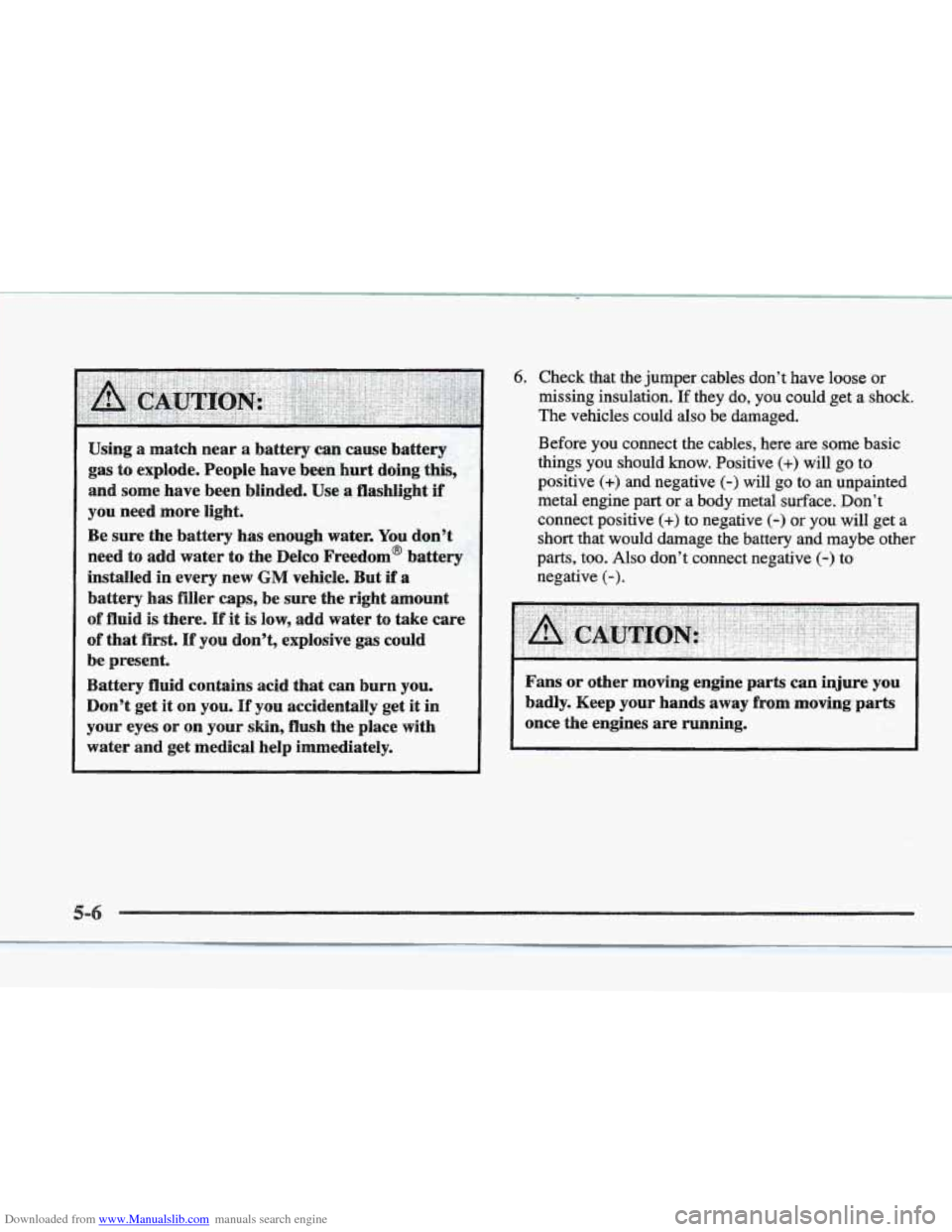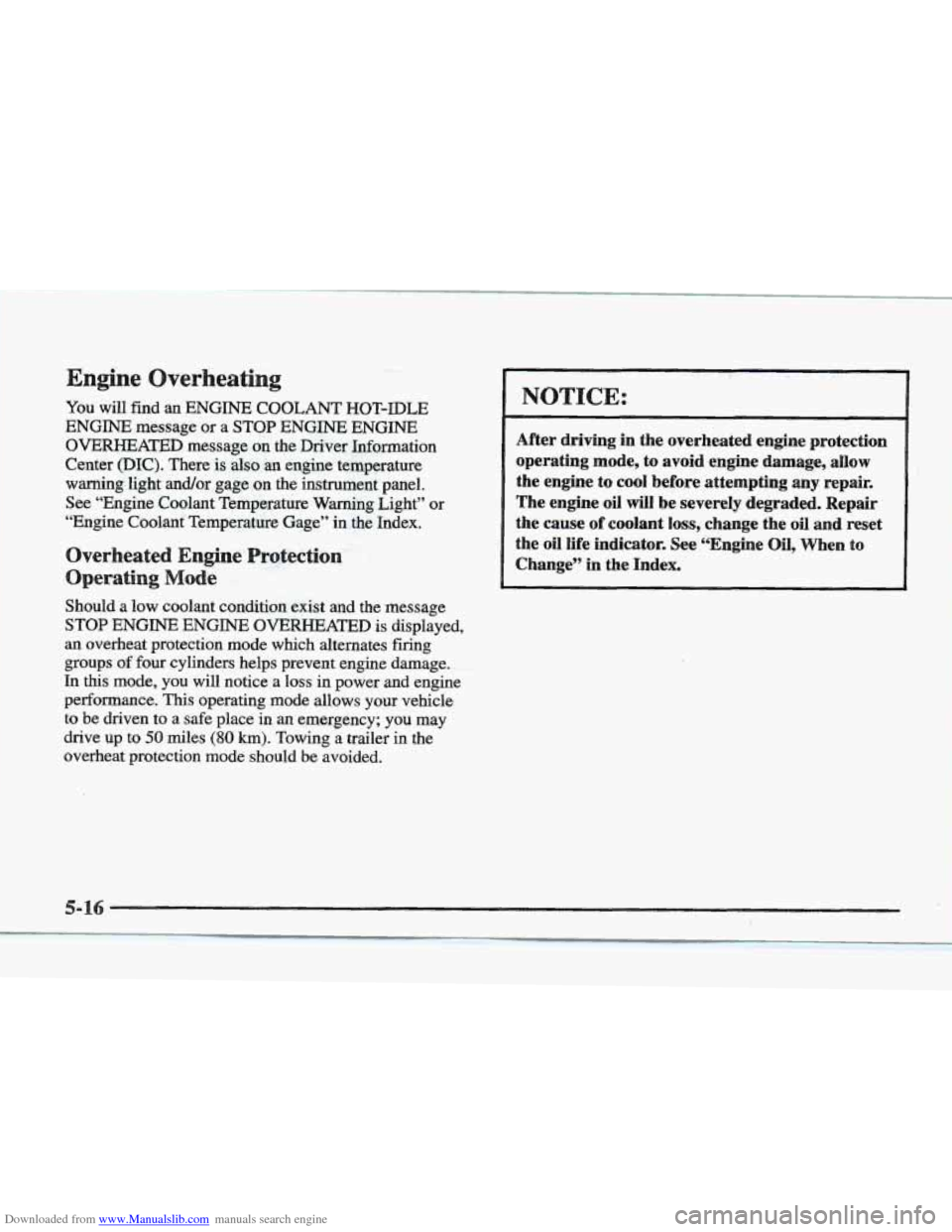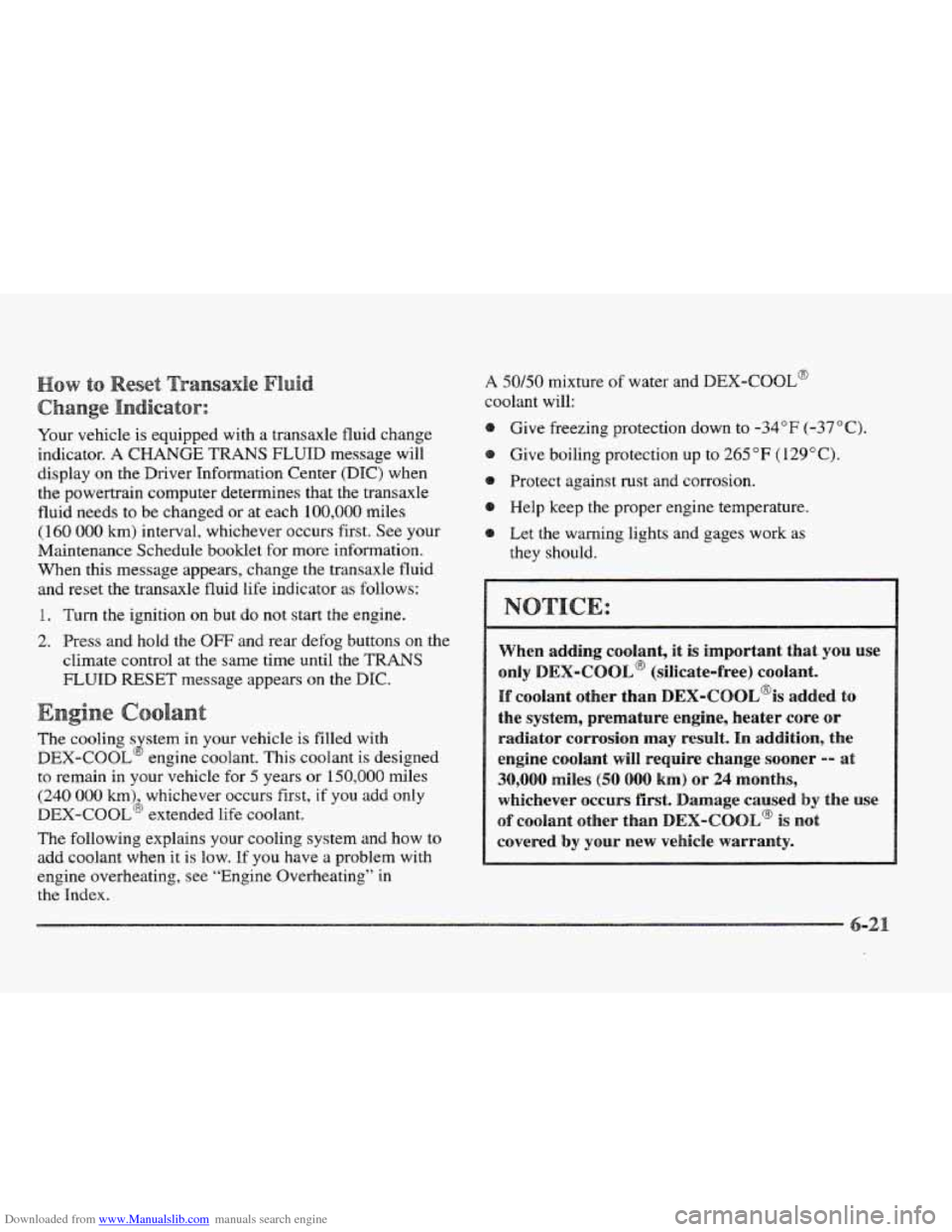Page 211 of 361
Downloaded from www.Manualslib.com manuals search engine .. . . .. .
Here are some tips for winter driving:
@ Have your vehicle in good shape for winter.
0 You may want to put winter emergency supplies in
your trunk.
. ...
Include an ice scraper; a small brush or broom, a supply
of windshield washer fluid, a rag, some winter outer
clothing, a small shovel, a flashlight, a red cloth and a
couple
of reflective warning triangles. And, if you will
be driving under severe conditions,
include a small bag
of sand, a piece of old carpet or a couple of burlap bags
to help provide traction. Be sure you properly secure
these items
in your vehicle.
Page 215 of 361

Downloaded from www.Manualslib.com manuals search engine Run your engine 'only as long'as you must. This saves
fuel. When you run the engine, make it go a little faster
than just idle. That is, push the accelerator slightly.
This
uses less fuel for the-heat that you get and it keeps the
battery charged.
You will need a well-charged battery to
restart the vehicle, and.possibly.for signaling
later on
with your headlamps. Let-the heater
run for awhile.
Then, shut'the ,engine
off 'and close the window almost
all the way to preserve the heat.
Start the engine again
and repeat this only when you feel really uncornfortable
from the cold. But do it as little
as possible. Preserve the
fuel as long as you can. To help keep warm, you can get
out of the vehicle and
do some fairly vigorous exercises
every half hour or
so until help comes.
.- . ,* . . _.
oading Your Ve
;" 1.
TIRE-LOA.DING INFORMATION
OCCUPANTS VEHICLE
CAP. WT.
FRT. CTR. RR. TOTAL LBS. KG
MAX. LOADING & GWR SAME AS VEHICLE
CAPACITY WEIGHT XXX COLD TIRE
TIRE SIZE SPEED PRESSURE
RTG
PSVKPa
FRT.
RR.
SPA.
IF TIRES ARE HOT, ADD 4PSV28KPa
SEE OWNER'S MANUAL FOR ADDITIONAL
. INFORMATION
Two labels on your.vehicle show how much weight it
may properly
carry. The Tire-Loading Information label
found
on the driver's door tells you the proper size,
speed rating and recommended inflation pressures for
the tires on your vehicle. It also gives you important
infomation
about the number of people that can be in
your vehicle and the total weight that you can carry.
This weight is called the Vehicle Capacity Weight and
includes the weight of all occupants, cargo and all
options not installed in the factory.
Page 228 of 361
Downloaded from www.Manualslib.com manuals search engine This light on the instrument
I panel will flash, indicating
The hazard warning flashers will work once the button
is pressed in regardless
of the key position.
hll out on the collar to turn the flashers off. When the
hazard warning flashers are on, the turn signals won’t
work since they are already flashing.
Page 230 of 361
Downloaded from www.Manualslib.com manuals search engine 2.
3.
4.
Get the vehicles close enough so the jumper cables
can reach, but be sure
the vehicles aren’t touching
each other.
If they are, it could cause a ground
connection you don’t want. You wouldn’t be able to
start your Cadillac and the bad grounding could
damage the electrical systems.
Turn off the ignition on both vehicles. Unplug
unnecessary accessories plugged into the cigarette
lighter.
Turn off all lamps that aren’t needed as well
as radios. This will
avoid sparks and help save both
batteries.
In addition, it could save your radio!
Open
the hoods and locate the batteries. Find the
positive (+) and negative (-) terminals on
each battery.
An electric fan can start up even when the engine
clothhg and tools away from any underhood
is not running and can injure you. Keep hands,
electric fan.
5. Start by removing the red positive (+)
terminal cover.
CAUTION:
Page 231 of 361

Downloaded from www.Manualslib.com manuals search engine Using a match near a battery can cause battery
gas to explode. People have been hurt doing this,
and some have been blinded. Use a flashlight if
you need more light.
Be sure the battery has enough water. You don’t
need
to add water to the Delco Freedom@ battery.
installed in every new
GM vehicle. But if a
battery has filler caps, be sure the right amount
of fluid is there. If it is IOW, add water to take care
of that first. If you don’t, explosive gas could
be present.
Battery fluid contains acid that
can burn you.
Don’t get it on
you. If you accidentally get it in
your eyes or on your skin, flush the place with
water
and get medical help immediately.
6. Check that the jumper cables don’t have loose or
missing insulation. If they do, you could get a shock.
The vehicles could
also be damaged.
Before
you connect the cables, here are some basic
things
you should know. Positive (+) will go to
positive
(+) and negative (-) will go to an unpainted
metal engine
part or a body metal surface. Don’t
connect positive
(+) to negative (-) or you will get a
short that would damage the battery and. maybe other
parts, too. Also don’t connect negative (-) to
negative
(-).
Fans or other moving engine parts can injure you
badly. Keep your hands away
from moving parts
once the engines are running.
Page 241 of 361

Downloaded from www.Manualslib.com manuals search engine . -.-
You will find an ENGINE COOLANT HOT-IDLE
ENGINE message or a STOP ENGINE ENGINE
OVERHEATED message on the Driver Information
Center
(IDIC). There is also an engine temperature
warning light andor gage on
the instrument panel.
See “Engine Coolant Temperature
Warning Light” or
“Engine Coolant Temperature Gage” in the Index.
Overheated Engine Protection
Should a low coolant condition exist and the message
STOP ENGINE ENGINE OVERHEATED is displayed,
an overheat protection mode which alternates firing
groups
of four cylinders helps prevent engine damage.
In this mode, you will notice a loss in power and engine
performance.
This operating mode allows your vehicle
to be driven to
a safe place in an emergency; you may
drive up to
50 miles (80 km). Towing a trailer in the
overheat protection mode
should be avoided.
NOTICE:
After driving in the overheated engine protection
operating mode, to avoid engine damage, allow the engine to cool before attempting
any repair.
The engine
oil will be severely degraded. Repair
the cause of coolant loss, change the
oil and reset
the
oil life indicator. See “Engine Oil, When to
Change” in the Index.
Page 263 of 361
Downloaded from www.Manualslib.com manuals search engine Spinning yoas wheels can destroy parts of your
vehicle as well as the tires. If you spin the wheels
~QQ fast while shifting your transaxle back and
forth,
you can destroy your transaxle.
For
information about using tire chains on your vehicle,
see “Tire Chains” in the Index.
First, turn your steering wheel left and right. That will
clear the area around your front wheels.
You should turn
your traction control system off. (See “Traction Control
System”
in the Index.) Then shift back and forth
between
REVERSE (R) and a forward gear, spinning the
wheels as little as possible. Release the accelerator pedal
while you shift, and press lightly
on the accelerator
pedal when the transaxle
is in gear. If that doesn’t get
you
out after a few tries, you may need to be towed out.
If you do need to be towed out, see “Towing Your
Vehicle” in the Index.
Page 284 of 361

Downloaded from www.Manualslib.com manuals search engine Your vehicle is equipped with a transaxle fluid change
indicator.
A CHANGE TRANS FLUID message will
display on
the Driver Information Center (DIC) when
the powertrain computer determines that the transaxle
fluid needs to be changed or at each
100,080 miles
(160 080 km) interval, whichever occurs first. See your
Maintenance Schedule booklet for more information.
When this message appears, change the transaxle fluid
and reset the transaxle fluid life indicator as follows:
I. Turn the ignition on but do not start the engine.
2. Press and hold the OFF and rear defog buttons on the
climate control at the same time until the
TRANS
FLUID RESET message appears on the DHC.
The cooling s stern in your vehicle is filled with
DEX-COOL engine coolant. This coolant is designed
to remain
in your vehicle for 5 years or 150,000 miles
(240 000 km) whichever occurs first, if you add only
DEX-COOL‘ extended life coolant.
2
The following explains your cooling system and how to
add coolant when
it is low. If YOU have a problem with
engine overheating, see “Engine Overheating”
in
the Index.
A 50/50 mixture of water and DEX-COOL@
coolant will:
@ Give freezing protection down to -34” F (-37°C).
Give boiling protection up to 265 OF (1 29°C).
Protect against rust and corrosion.
Help keep the proper engine temperature.
Let the warning lights and gages work as
they should.
When adding coolant, it is important that you use
only DEX-COOL~ (silicate-free) coolant.
If coolant other than DEX-COOL@is added t~
the system, premature engine, heater core or
radiator corrosion may result. In addition, the
engine coolant
will require change SOQWW 0- at
34b,8(Bo miles (50 000 km) or 24 months,
whichever CD~CUP’S first. Damage caused
of coolant other than
covered
by your new vehicle warranty.